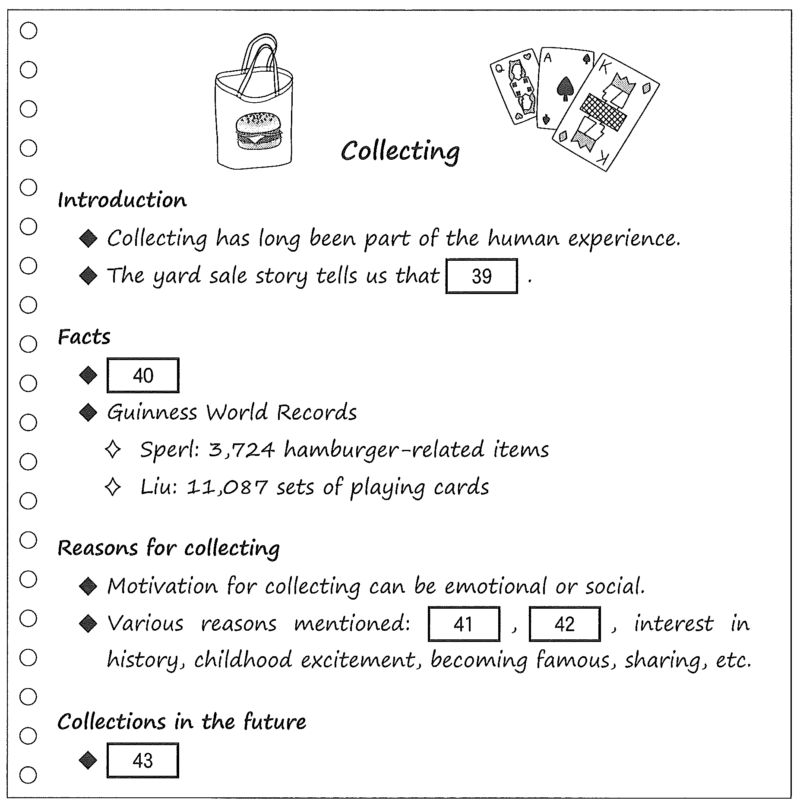2023年度の大学入学共通テスト英語第6問Aの解説をしています。疑問点が残らないよう、解き方の手順も踏まえて一問一問どこよりも丁寧に説明します。
問題
You are in a discussion group in school. You have been asked to summarize the following article. You will speak about it, using only notes.
Collecting
Collecting has existed at all levels of society, across cultures and age groups since early times. Museums are proof that things have been collected, saved, and passed down for future generations. There are various reasons for starting a collection. For example, Ms. A enjoys going to yard sales every Saturday morning with her children. At yard sales, people sell unwanted things in front of their houses. One day, while looking for antique dishes, an unusual painting caught her eye and she bought it for only a few dollars. Over time, she found similar pieces that left an impression on her, and she now has a modest collection of artwork, some of which may be worth more than she paid. One person’s trash can be another person’s treasure. Regardless of how someone’s collection was started, it is human nature to collect things.
In 1988, researchers Brenda Danet and Tamar Katriel analyzed 80 years of students on children under the age of 10, and found that about 90% collected something. This shows us that people like to gather things from an early age. Even after becoming adults, people continue collecting stuff. Researchers in the field generally agree that approximately one third of adults maintain this behavior. Why is this? The primary explanation is related to emotions. Some save greeting cards from friends and family, dried flowers from special events, seashells from a day at the beach, old photos, and so on. For others, their collection is a connection to their youth. They may have baseball cards, comic books, dolls, or miniature cars that they have kept since they were small. Others have an attachment to history; they seek and hold onto historical documents, signed letters and autographs from famous people, and so forth.
For some individuals there is a social reason. People collect things such as pins to share, show and even trade, making new friends this way. Others, like some holders of Ginness World Records, appreciate the fame they achieve for their unique collection. Cards, stickers, stamps, coins, and toys have topped the “usual” collection list, but some collectors lean toward the more unexpected. In September, Guiness World Records recognized Harry Sperl, of Germany, for having the largest hamburger-related collection in the world, with 3,724 items “hamburger.” Similarly, Liu Fuchang, of China, is a collector of playing cards. He has 11,087 different sets.
Perhaps the easiest motivation to understand is pleasure. Some people start collections for pure enjoyment. They may purchase and put up paintings just to gaze at frequently, or they may collect audio recordings and old-fashioned vinyl records to enjoy listening to their favorite music. This type of collector is unlikely to be very interested in the monetary value of their treasured music, while others collect objects specifically as an investment. While it is possible to download certain classic games for free, having the same game unopened in its original packaging, in “mint condition,” can make the game worth a lot. Owning various valuable “collector’s items” could ensure some financial security.
This behavior of collecting things will definitely continue into the distant future. Although the reasons why people keep things will likely remain the same, advances in technology will have an influence on collections. As technology can remove physical constraints, it is now possible for an individual to have vast digital libraries of music and art that would have been unimaginable 30 years ago. it is unclear, though, what other impacts technology will have on collections. Can you even imagine the form and scale the next generation’s collections will take?
Your notes:

問1 Choose the best option for ( 39 ).
- a great place for people to sell things to collectors at a high price is a yard sale
- people can evaluate items incorrectly and end up paying too much money for junk
- something not important to one person may be of value to someone else
- things once collected and thrown in another person’s yard may be valuable to others
問2 Choose the best option for ( 40 ).
- About two thirds of children do not collect ordinary things.
- Almost one third of adults start collecting things for pleasure.
- Approximately 10% of kids have collections similar to their friends.
- Roughly 30% of people keep collecting into adulthood.
問3 Choose the best option for ( 41 ) and ( 42 ). (The order does not matter.)
- desire to advance technology
- fear of missing unexpected opportunities
- filling a sense of emptiness
- reminder of precious events
- reusing objects for the future
- seeking some sort of profit
問4 Choose the best option for ( 43 ).
- Collections will likely continue to change in size and shape.
- Collectors of mint-condition games will have more digital copies of them.
- People who have lost their passion for collecting will start again.
- Reasons for collecting will change because of advances in technology.
解説 問1
Choose the best option for ( 39 ).
( 39 )に最適な選択肢を選んでください
( 39 )は Your notes の introduction の二つ目のリストにあります。
The yard sale story tells us that ( 39 ).
ヤードセールの話は私たちに( 39 )ということを教えてくれます
ヤードセールの話は、第一段落にあります。そこを読み終えたらすぐに、この問題に取り組むといいでしょう。
選択肢を確認しましょう。
1. a great place for people to sell things to collectors at a high price is a yard sale
物を収集家に高値で売るのに、最適な場所はヤードセールです
ヤードセールについては第一段落にこうあります。
At yard sales, people sell unwanted things in front of their houses.
ヤードセールでは、人々は自分の家の前で不要なものを売ります
「不要なものを売る」とありますが、「高値で売りつける」という話は本文にありません。この選択肢は違います。
2. people can evaluate items incorrectly and end up paying too much money for junk
人々は商品を間違って評価し、ジャンク品に多額のお金を支払うことになる可能性があります
第一段落にこうあります。
One day, while looking for antique dishes, an unusual painting caught her eye and she bought it for only a few dollars.
ある日、アンティークの食器を探していると、珍しい絵が目に留まり、わずか数ドルで購入しました。
本文の内容では「only a few dollars / わずか数ドル」とあります。お得に買うことができたようです。ヤードセールで高値で買ってしまうことがあるかもしれませんが、それについては本文で書かれていません。この選択肢は違います。
3. something not important to one person may be of value to someone else
ある人にとって重要でないものは、他の誰かにとっては価値があるかもしれません
第一段落にこうあります。
One person’s trash can be another person’s treasure.
誰かのゴミが誰かの宝物になることもあります。
選択肢の内容と同じです。この選択肢が正解です。
4. things once collected and thrown in another person’s yard may be valuable to others
かつて集められて他人の庭に投げられたものは、他の人にとって価値があるかもしれません
ヤードセールは、他人の庭に物を投げ捨てることではありません。この選択肢は違います。
ということで、正解は「3」です。

「ヤードセール」は日本にはあまりない習慣ですから、少しイメージしづらいかもしれません。アメリカでは庭が広いので、そういうことをよくやるそうですね。
解説 問2
Choose the best option for ( 40 ).
( 40 )に最適な選択肢を選んでください
( 40 )は Your notes の Fact のリスト一つ目です。ちなみに Fact のリストもう一つは、Guiness Wordl Records として、二つ挙げられています。
Sperl: 3,724 hamburger-related items
Liu: 11,087 sets of playing cards
この内容は、第三段落にあります。つまり( 40 )の内容は第二段落にあると考えられます。それを踏まえて、選択肢を確認しましょう。
1. About two thirds of children do not collect ordinary things.
子どもの約 3 分の 2 は、普通のものを収集しません。
2. Almost one third of adults start collecting things for pleasure.
大人のほぼ 3 分の 1 が、楽しみのために物を集め始めます。
3. Approximately 10% of kids have collections similar to their friends.
約 10% の子供が、友達と同じようなコレクションを持っています。
4. Roughly 30% of people keep collecting into adulthood.
約 30% の人が大人になっても収集を続けます。
全ての選択肢が、何らかの割合について書かれてあります。そういう数字が出てくるのは、第二段落に二か所あります。そのうちの一つがこれです。
In 1988, researchers Brenda Danet and Tamar Katriel analyzed 80 years of students on children under the age of 10, and found that about 90% collected something.
1988 年、研究者のブレンダ・ダネットとタマー・カトリエルは、10 歳未満の子供に関する 80 年間の学生を分析し、約 90% が何かを収集していることを発見しました。
子供の90%が何かを集めているという話です。子供に触れている選択肢は「1」と「3」です。ですが、どちらもこの本文の内容と合いません。ということでこの二つの選択肢は違います。
次に割合的な数字が出てくるのは、この部分です。
Even after becoming adults, people continue collecting stuff. Researchers in the field generally agree that approximately one third of adults maintain this behavior.
大人になっても人は物を集め続けます。この分野の研究者は一般に、成人の約 3 分の 1 がこの行動を維持していることに同意しています。
1/3=0.33…≒30% つまり、これは選択肢「4」の内容です。ということで、正解は「4」です。

数字がたくさん出てきて、少し焦ります。「大人」と「子供」に分けて考えると、やりやすくなるのではないでしょうか。
解説 問3
Choose the best option for ( 41 ) and ( 42 ). (The order does not matter.)
( 41 )と( 42 )に最適な選択肢を選んでください。(順序は問いません)
( 41 )と( 42 )は Your notes の Reasons for collecting にあります。
・Motivation for collecting can be emotional or social.
収集の動機は、感情的または社会的です。
・Various reasons mentioned: ( 41 ), ( 42 ), interest in history, childhood excitement, becoming famous, sharing, etc.
挙げられた様々な理由:( 41 )、( 42 )、歴史への興味、幼少期の興奮、有名になること、共有など。
第二段落の終盤から第四段落まで、「コレクションの動機」について書かれています。
第三段落に、こうあります。
Some save greeting cards from friends and family, dried flowers from special events, seashells from a day at the beach, old photos, and so on.
友人や家族からのグリーティングカード、特別なイベントでのドライフラワー、ビーチでの 1 日の貝殻、古い写真などを保存する人もいます。
「思い出」として残すという動機です。この内容と関係する選択肢は「4」です。
4. reminder of precious events
貴重なイベントの思い出
この選択肢が一つ目の正解です。
第四段落に、こうあります。
Owning various valuable “collector’s items” could ensure some financial security.
さまざまな貴重な「コレクターアイテム」を所有することで、ある程度の経済的安全を確保できます。
コレクションによって利益を得ようという動機ですね。この内容と関係する選択肢は「6」です。
6. seeking some sort of profit
何らかの利益を求めること
この選択肢が二つ目の正解です。
残りの選択肢を確認しましょう。
1. desire to advance technology
技術を進歩させたいという欲求
2. fear of missing unexpected opportunities
思わぬチャンスを逃すことへの恐怖
3. filling a sense of emptiness
空虚感を満たすこと
5. reusing objects for the future
将来のために物を再利用すること
これらに関しては、そういう記述はありませんでした。
ということで、正解は「4」「6」です。

「コレクションの理由」は、かなり多く書かれてあります。一つ理由が語られたら、Your notes をチェックして、そこにあるものには印をしておくといった工夫しておくと、後で見直しやすいかと思います。
解説 問4
Choose the best option for ( 43 ).
( 43 )に最適な選択肢を選んでください
( 43 )は Your notes の「Collection in the future / 未来のコレクション」にあります。「未来のコレクション」については、最終段落にあります。最終段落の内容を確認したうえで、問題に取り組むのがいいでしょう。
選択肢を確認しましょう。
1. Collections will likely continue to change in size and shape.
コレクションのサイズと形は今後も変化し続けるでしょう。
最終段落に、こうあります。
Can you even imagine the form and scale the next generation’s collections will take?
次世代コレクションの形と規模を想像できますか
これは選択肢にある通り、今後もコレクションの形と規模が変化するので、それがどういうものになるのか「想像できない」ということです。この選択肢が正解です。
2. Collectors of mint-condition games will have more digital copies of them.
新品同様のゲームのコレクターは、より多くのデジタルコピーを所有するでしょう
「mint-condition」については、第四段落にこうあります。
While it is possible to download certain classic games for free, having the same game unopened in its original packaging, in “mint condition,” can make the game worth a lot.
一部の古典的なゲームを無料でダウンロードすることができる一方で、同じゲームをオリジナルのパッケージで未開封の「新品同様」で持っていると、そのゲームの価値は高くなります
つまり「mint-condition」のコレクターとは、「デジタルコピー」ではなく、「実物」をコレクションする人のことです。この選択肢は違います。
3. People who have lost their passion for collecting will start again.
収集への情熱を失った人々は、再び始めるでしょう
そのような記述はありません。この選択肢は違います。
4. Reasons for collecting will change because of advances in technology.
収集の理由は、技術の進歩により変化します
最終段落に、こうあります。
Although the reasons why people keep things will likely remain the same, advances in technology will have an influence on collections.
人々が物を保管する理由は今後も変わらないと思われますが、テクノロジーの進歩はコレクションに影響を与えるでしょう
「収集の理由」は変化しないと言っています。この選択肢は違います。
ということで、正解は「1」です。

選択肢「1」の該当部分は、疑問文になっていますので、一見それとわかりづらいですね。「想像できますか」→「想像できませんよね」という反語表現です。なぜ「想像できないか」というと、「変化し続ける」からです。行間の意図を読み取らないといけませんでした。



コメントをどうぞ